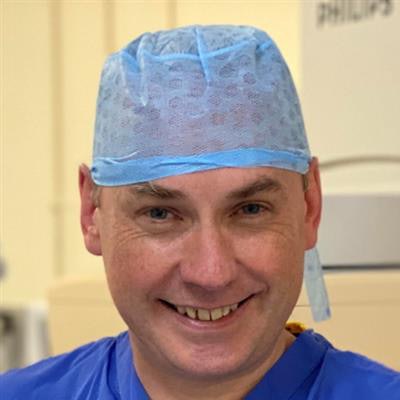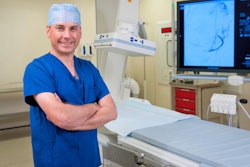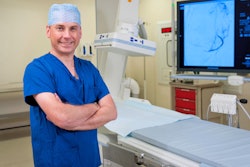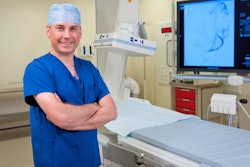
I doubt many people go into healthcare to offer "a good-enough service." There is no inspiring vision in the average nor stirring narrative in the adequate. Healthcare is seen as urgent, heroic, saintly, and uncompromising. Phrases like "going the extra mile", "doing the right thing," and "pulling out all the stops" are widely used, at least in the U.K.
The Royal College of Radiologists (RCR) Quality Standard for Imaging (QSI) provides a starting point in setting out a comprehensive quality baseline for a radiology department with detailed descriptors across many domains. It describes a service fulfilling the imaging needs of the population it serves quickly, safely, effectively, collaboratively, and with dignity.
 Dr. Chris Hammond.
Dr. Chris Hammond.An excellent imaging service should (arguably) also provide its workforce with a career structure that allows them to personally and professionally flourish with interesting and stimulating work and the opportunity to innovate or spread the innovations of others.
An excellent service may require decisions such as the three outlined below:
- You have a new MRI scanner that can provide lots of additional sequences that increase diagnostic sensitivity slightly but also increase scan time by 25%. Do you implement them?
- A trial identifies that a new cancer surveillance protocol improves recurrence detection rates but involves twice as much imaging as the previous protocol. Do you agree with its introduction?
- You review non-urgent overnight inpatient imaging and find that next-morning reporting rarely (but not never) results in harm. How much expensive overnight resource do you allocate to manage this risk?
But could the service deliver more out-of-hours reporting without having any impact on daytime capacity? Would it have the redundancy to increase scan times for some imaging by 25% and the funding to cope with twice as much imaging as the previous protocol? Might a service implementing such change without challenge be an impossible to fund and undesirable fairytale lacking an understanding of the wider societal context of resource allocation?
Where do we draw the line at good enough? Does it matter if a particular decision might expose a small number of patients to harm if it will mitigate other operational risks? Is the potential stifling of innovation (for example, by not funding new devices or drugs or preventing the use of new imaging sequences) reasonable if money is productively diverted elsewhere? Does a culture that accepts good enough inevitably eventually lead to degeneration into a rump or failing service? What do our patients and their relatives think? What compromises are they willing to make or willing to allow us to make on their behalf?
If we place limits on healthcare professionals' autonomy to manage patients and services as they think appropriate, does that reduce them to highly skilled pieceworkers, moving from one patient to the next, constrained by the mandates of a system they have limited power to alter? What does that do for one's professional satisfaction, identity, and social role?
And yet much of healthcare is repetitive and mundane piecework. In radiology it's the backlog of thousands of routine scans, the GP reporting basket, the waiting list for an image-guided biopsy or a fistuloplasty. This work is not sexy or cutting edge, but that does not mean it's not fundamental to what we do and who we are. And, of course, each of these mundane events is a source of considerable anxiety, and may even be life-changing, for the patient involved.
Wicked questions
Lots of questions -- paragraphs of them. To reach an answer needs an exploration of ethics and morality, an understanding of organizational psychology, and a wider conversation about what we consider important.
Philosophers have wrangled with these big questions for centuries without a definitive conclusion. Yet decisions need to be made and need to be made now. They will not wait for a psycho-sociocultural analysis of how modern society approaches moral philosophy or even for a cost-utility analysis. How then do we make them?
The answer, I think, is to recognize that while the questions (and many others in healthcare) seem simple, almost binary (implement or not), in fact, they are wicked.
A wicked question has a number of characteristics, including the lack of a clear definition, the involvement of many stakeholders (with different priorities, ethics, and world views), and the lack of clear criteria for determining whether the answer arrived at was 'correct.'
For example, implementing the new surveillance program described above might be enthusiastically welcomed by patients with the particular cancer involved but not by others who see resources being diverted.
We may be embraced by clinicians excited by the opportunity to improve their service or resented for the increased workload. A review describing the number of additional recurring cancers identified and the number of additional scans undertaken might equally be interpreted as identifying a great step forward in care or a colossal waste of money.
Management of wicked problems can be undertaken in a variety of ways, from the imposition of a solution by those who wield power (and who may or may not own the consequences of their decision) to broad collaboration and iterating to an outcome where the driver is agreement on a solution rather than the solution itself.
We might want to implement the new cancer follow-up protocol, or we might not, but all stakeholders should feel able to contribute to the decision and at least be satisfied that their voice has been heard and understood -- even if the ultimate decision made was not what they wanted.
Where does this leave us?
The concept of excellence is not fixed: It's constantly moving, changing, and adapting. It requires ongoing conversations: with the people who deliver, pay for, and organize the service; with the people who use it; and, crucially, with the people who experience it -- our patients. It means exploring what we can offer and then delivering it well.
There may be agreed metrics or standards, and these may change over time, but these metrics need to be meaningful for everyone, otherwise, they will be resented or ignored. Excellence, however, does not mean we need to do or offer everything. What we choose to do is up to us to decide. Good enough can be, and often is, excellent.
This collaboration and shared purpose are the protection against the professional disenfranchisement associated with the mundane. Feeling part of a bigger whole, of a movement, drives engagement and job satisfaction, as the (well-rehearsed and possibly apocryphal) story about President John F. Kennedy and a cleaner at the U.S. National Aeronautics and Space Administration illustrates.
The RCR QSI document sets exacting standards for good enough which protects against mediocrity. Collaboration in their implementation and beyond will drive services to be better, not worse.
Excellence is not an endpoint, it's a process. It's bigger than the individual decisions made about whether or not to do a particular thing. Decisions about increasing our sequences, adopting a new surveillance strategy, resourcing overnight reporting, and a myriad of others require us to work together.
Working together for a common goal. That's excellence in radiology.
Dr. Chris Hammond is a consultant vascular radiologist and clinical director for radiology at Leeds Teaching Hospitals NHS Trust, Leeds, U.K.
The comments and observations expressed herein do not necessarily reflect the opinions of AuntMinnieEurope.com, nor should they be construed as an endorsement or admonishment of any particular vendor, analyst, industry consultant, or consulting group.




















